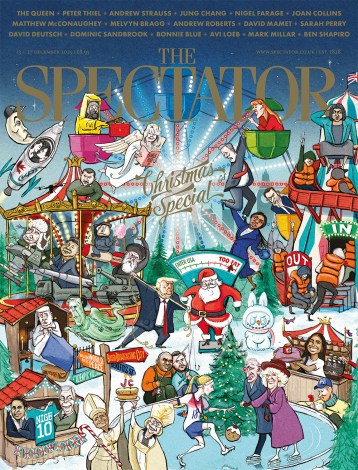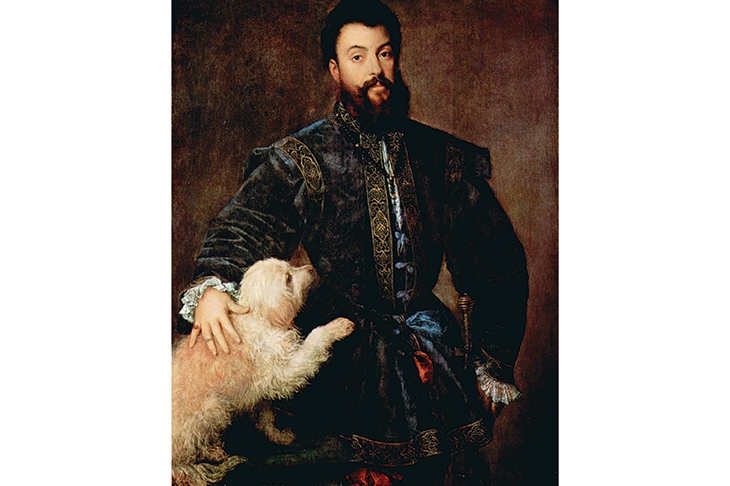What is it that distinguishes humans from other animals? The default answer nowadays is tediously misanthropic, but a more interesting distinction is that humans keep pets. Why this should be is the subject of this book. Jacky Colliss Harvey investigates the men and women who have owned, doted on, and in some cases mistreated their pets, in literature, painting, the movies and history. This begins 26,000 years ago, when a boy and his dog went exploring in bear caves in the south of France. The evidence was discovered in petrified tracks at Chauvet in the Ardèche in 1994.
Harvey has a scholar’s aspiration and she is tremendously erudite, ranging far and wide, from Jacques Derrida (‘The animal looks at us and we are naked before it’) to John Wick (an action movie starring Keanu Reeves, who visits terrible vengeance on the villains who have killed his dog), half-answering questions about why exactly we have pets.
What is their evolutionary purpose? Do we keep them because we have egos, and like to command? Is it that they bond us to one another? Are pets an antidote to our exploitation of animals? Or, conversely, does keeping an animal reinforce our sense of being masters of nature? Is it because they make us laugh? Perhaps they are merely a kind of accessory? (Cora Pearl, the notorious Parisian courtesan, dyed her dog blue to match a blue dress.) Or, as the poet Christopher Smart had it, was his cat Jeoffrey, ‘an instrument for the children to learn benevolence upon’?
And what is a pet anyway? The word is difficult to define. It comes from northern Britain, and originally meant ‘lamb’. The OED gives us ‘an animal kept for pleasure or companionship’, which is accurate but vague. What is a warhorse? A sheepdog? What about a stick insect? Does a pet have to be responsive?
All these questions are put by Harvey, and then, as best she can, answered by means of well-informed conjecture spiced with anecdote. Her beautifully illustrated book is organised thematically and is perhaps best thought of as a series of essays on the various themes that the relationships between kept animals and humans throw up, such as choosing, naming, communicating and losing. However, for all its research into deeper matters, the real pleasure of The Animal’s Companion lies in its stories. And they come thick and fast.
The Barrison Sisters, a Vaudeville act of the 1890s, used to perform a song entitled ‘Do You Want to See My Pussy?’, at the end of which they would lift their skirts to reveal a kitten in a pouch over the crotch. According to Shelley, Byron kept, in his house in Italy, ‘eight enormous dogs, three monkeys, five cats, an eagle, a crow and a falcon’. As a boy, Abraham Lincoln had a pet pig and carved a cradle for it. These three stories come on succeeding pages.
Turner used one of his own paintings, ‘Fishing upon the Blythe-Sand’, as a cat- flap. Emily Brontë nailed the difference between cats and dogs: ‘We cannot stand up under comparison with the dog. He is infinitely too good. But the cat… is extremely like us in disposition.’ Dickens had three ravens, all called Grip. Raccoons were commonplace pets in 16th-century Mexico. The word ‘tabby’ derives from the French tabis, the word for the striped silk woven in Attabiya, a district in Baghdad. Hogarth’s pug was called Trump — jocular 18th-century slang for ‘fart’.
Such anecdotes may sound trivial, but the subject of our relationship with animals is a serious one, and has attracted much philosophical attention. Harvey shirks none of this — even though the reader may be impatient for the next juicy tidbit.
The assumption that those who love their pets necessarily love animals in general is certainly questionable. Jan Morris, who lives in Wales, has tremendous contempt for sheep, but writes wonderfully about cats. As does Harvey. She describes one of her own, dying, as: ‘Quills for bones and thistledown for fur, a delicate fetish where there had been a cat.’
The Animal’s Companion: People and their Pets A 26,000-Year-Old Love Story
Author: Jacky Colliss Harvey
Publisher: Allen & Unwin
Page count: 294
Price: £14.99






Comments